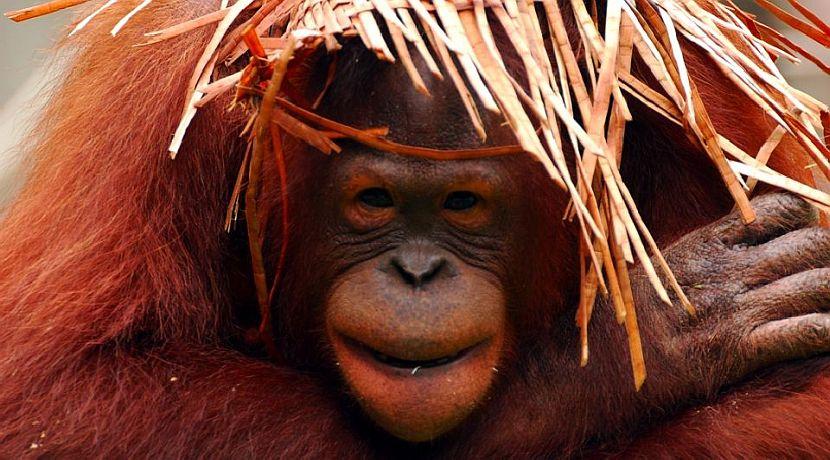People often ask us what they will be getting up to when they join us on one of our projects and the answer always changes dependent on where they are going. With the work never ending on the project sites, we managed to tie down Natasha, the coordinator on The Great Projects' flagship project, The Great Orangutan Project, to tell you what volunteering life is like on a typical day in Borneo as a orangutan volunteer, and why volunteers play such a crucial part in the running of the wildlife centre. Over to you Natasha!
A typical day at Matang begins with gibbon song between 6.30-7am, so man-made alarms are often not required! Work commences at 8.15am, when volunteers are tasked with assisting with husbandry work for a variety of species – sun bears, macaques, gibbons and of course, the orangutan. Groups of volunteers are split into smaller working groups each day and rotated through the different animal areas. Due to the high standards of the husbandry work we do and with the help of volunteers, animal welfare in general at the centre has improved significantly over the years. Husbandry is not only about cleaning up after the animals, which of course helps to keep them healthy, but is also about presenting their varied and nutritious daily feed in novel and enriching ways to inspire natural behaviour and keep the animals entertained for the day. This is also a great time for volunteers to have an opportunity to observe the animals, get to know the individuals and learn about their behaviour and histories.

Afternoon tasks can be anything from maintenance, to organic farming, to further enrichment work for the animals. Jobs assigned to volunteers are well planned and are always of benefit to either the animal's resident at Matang Wildlife Center, or to the wider work done by the Orangutan Project in Sarawak. Matang is unique among the 8 rehabilitation centres on Borneo and Sumatra in that it is attempting to rescue and rehabilitate all protected wildlife within Sarawak; not just the orangutan. This means that the potential of Matang to be a conservation tool for all local endangered species is almost unlimited. However it also presents a huge challenge as it is almost impossible to be adequately informed about the basic biology, ecology and rehabilitation techniques of every animal living on Borneo! It also means it is an excellent place to volunteer, as you will meet animal species that you have never heard of before and learn about the amazing biological diversity of the island of Borneo.

People that visit Matang, whether tourists or volunteers, are often surprised to see animals in captivity as they assume that in a rehabilitation centre all of the animals will be roaming free. The vast majority of the animals resident at Matang have been confiscated or surrendered from illicit pet trade; this means taken from their natural habitat (often as a result of their mums being killed), kept in highly inadequate housing for days/weeks/years, fed an incorrect diet and being incredibly humanised. All of these factors mean that an animal rescued from this is unlikely to return to a successful life in the wild, and caring for animals with a long life expectancy in a sanctuary for their lifetimes can be hard work and expensive.
This is where volunteers can be invaluable to a centre like Matang. Having people join the work force for short periods of time means enrichment is always varied, enthusiasm is always high and we are able to achieve great standards of captive management for a range of different species. If rehabilitation and release into the wild were the only goals for the animals at Matang, it would actually be detrimental to have a volunteer program that exposed these animals to lots of different people – the more that an animal is exposed to and cared for by humans, the less likely it is to retain truly wild instincts and return to a successful life in the forest. However, in a sanctuary setting, volunteers can be a hugely useful presence in the lives of the animals, and volunteers at Matang make a positive difference to the lives of the long-term residents on a daily basis.

It is challenging, of course, to maintain man-made structures in the Bornean rainforest, so cleaning, painting and general upkeep of enclosures is a common task for volunteers. Since Matang is an active rescue centre, there are always new animals arriving too, and therefore there is always a need for new enclosures. Construction workers are employed so that the building work is continuous and not solely dependent on volunteers, but it is very common to see volunteers assisting on these building sites, mixing cement, clearing land, wheel-barrowing tools and bricks to the site and doing whatever else is useful!

Occasionally, volunteers will catch a glimpse of the semi-wild orangutan living around the centre (especially if they take an interest in the current construction project), or happen to see the youngest orangutan making their way into the jungle for their daily rehabilitation training with their keepers, but this is not a featured 'product' as we want to keep these animals' exposure to people to a minimum. However, the money that volunteers pay to join our project pays the salaries of the keepers that care for these orangutan, so volunteers are indirectly essential to the rehabilitation process, where it is possible.

We hope Natasha has helped to answer any questions you may have had, and maybe even inspired you to help out yourself, but if you have any extra questions about this or any other project then we are always here to help!














